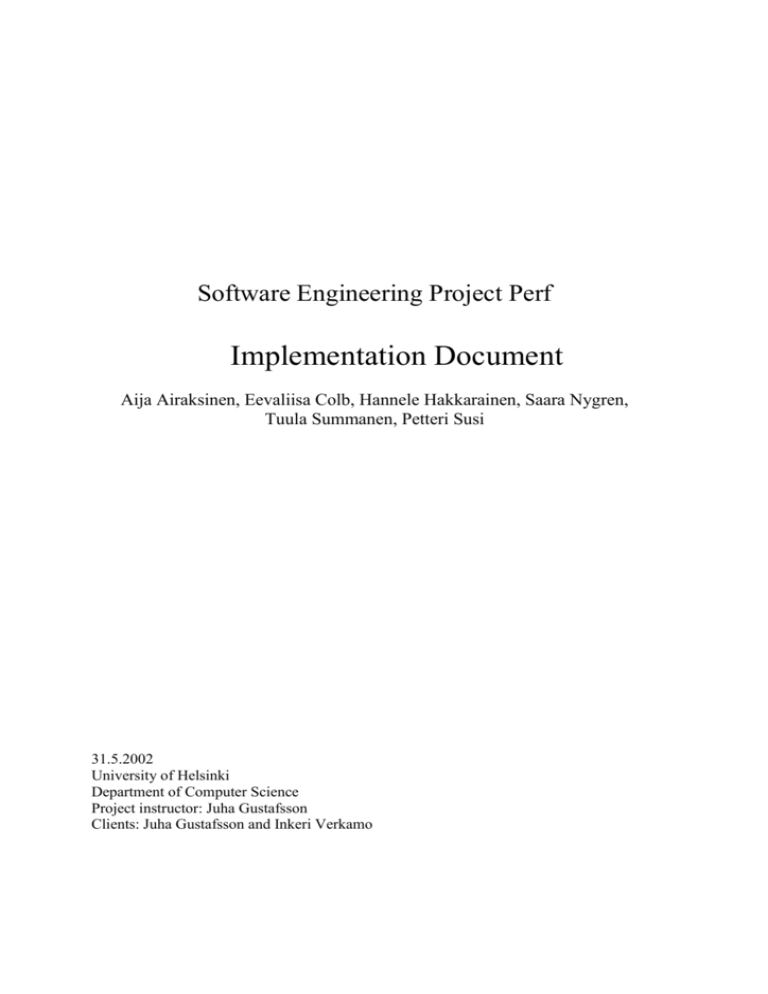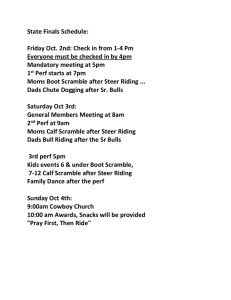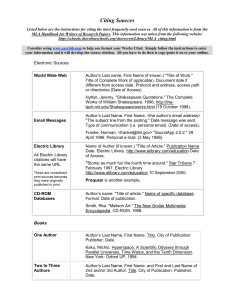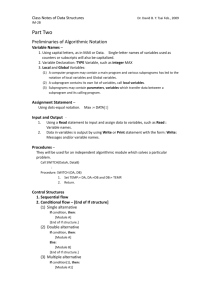3. Modifications to Maisa
advertisement

Software Engineering Project Perf Implementation Document Aija Airaksinen, Eevaliisa Colb, Hannele Hakkarainen, Saara Nygren, Tuula Summanen, Petteri Susi 31.5.2002 University of Helsinki Department of Computer Science Project instructor: Juha Gustafsson Clients: Juha Gustafsson and Inkeri Verkamo i VERSION DATE COMMENT 1.0 31.5.2002 THE FIRST VERSION Contents APPENDICES ....................................................................................................................................... I 1. INTRODUCTION.......................................................................................................................... 1 2. CHANGES TO DESIGN ............................................................................................................... 1 2.1 TYPICAL EXECUTION PATHS ....................................................................................................... 1 2.2 ADDITIONAL CONSTRAINTS ........................................................................................................ 1 2.3 INTERACTION DIAGRAM MESSAGES ............................................................................................ 1 2.3.1 Message Order .................................................................................................................... 2 2.3.2 Forks ................................................................................................................................... 2 2.3.3 Loops ................................................................................................................................... 2 2.5 ACTIVITY DIAGRAM HANDLER SUBSYSTEM ............................................................................... 3 3. MODIFICATIONS TO MAISA ................................................................................................... 3 3.1 PROLOG FILE FORMATS .............................................................................................................. 3 3.1.1 Collaboration Digram File Format .................................................................................... 4 3.1.2 Collaboration Diagram File Format .................................................................................. 4 3.2 CHANGES TO PACKAGE MAISA ................................................................................................. 4 3.3 CHANGES TO PACKAGE MAISA.DATASTRUCT ........................................................................... 4 4. REFERENCES ............................................................................................................................... 5 Appendices APPENDIX A Javadoc-produced documentation of the software. 1 1. Introduction This document describes the implementation of the software Perf. Perf is an extension to the MAISA metrics tool [WWW02], which can be used to measure the quality of sofware in its design phase. Perf adds to the MAISA tool the functionality for measuring memory usage of a program using various UML diagrams describing the program. The major changes made to the design of Perf are discussed in chapter 2. Modifications to the MAISA tool are listed in chapter 3. The software’s detailed documentation produced using the Javadoc tool is included in appendix A. 2. Changes to Design Most of the changes to the software's design [PER02a] were minor and are not listed in this document explicitly. The Javadoc documentation of the software found in appendix A describes the design of each class after the completion of the implementation phase. No modifications were made to the program's architecture. No major modifications were made to the program's subsystems’ designs. The rest of this chapter lists the larger modifications made after the design phase. 2.1 Typical Execution Paths All the features of first and second priority [PER02a] were covered in the design document [PER02b]. The second priority feature of searching for the most typical execution path in a scenario and calculating its memory usage estimates, was not implemented due to limitations of implementation and testing schedule. 2.2 Additional Constraints The implementation introduced several new constraints of the software in addition to the constraints specified in the requirements specification [PER02a] and in the design document [PER02b]. If an interaction diagram includes a loop in which the interaction diagram's message chain forks (see chapter 2.1), only one fork of the message chain can exit the loop in that interaction diagram. The software provides very little information about errors in defective UML diagrams used in calculation of memory usage estimates. 2.3 Interaction Diagram Messages Messages in an interaction diagram handled by InteractionDiagramHandler are always in one message chain. In this chain the messages are ordered by their sequence numbers, which can be 2 accessed by method CMessage.getNumber(). The message chain can include forks and loops, marked using the messages' sequence numbers. 2.3.1 Message Order The sequence number of a message consists of Parts and Separators as follows: Number ::= (Part | InvalidPart) (Separator Number) ? Separator ::= “.” A Part is a string which can be parsed as a signed decimal integer and thus be transformed into an integer with the method Integer.parseInt(String). InvalidPart is a string which does not contain a parsable integer and therefore cannot be transformed into an integer with the method Integer.parseInt(String). Sorting a message chain containing one or more InvalidParts (including empty string) may lead to undefined results. The messages are ordered by their sequence numbers using the following rules: The order of Parts is the order of their integer values. InvalidParts are considered equal (e.g. "" == "foo" == null). InvalidParts precede Parts in the ordering. The order of messages is the order of their sequence numbers. If n-1 parts (from left to right) of a sequence numbers are equal, the order of the n'th part is the order of the sequence numbers. A sequence number containing n parts precedes a sequence number containing n+1 parts, when the n parts (from left to right) are equal for both the messages. 2.3.2 Forks When two or more alternative messages follow a message, the message chain forks. Alternative messages have a probability (accessed by the method CMessage.getProbability()) of less than one. The messages which are alternative to each other (i.e. the messages which are in one fork) have sequence numbers as follows: Every sequence number has n parts The first parts up to the last (i.e. n-1 parts) of every sequence number are equal The last part (i.e. the n'th part) of each sequence number is different A and B refer to alternative messages in a same fork: If the sequence number of A precedes the sequence number of B, then all the sequence numbers of the messages on the chain following A, until the chain's end, precede the sequence number of B. 2.3.3 Loops Messages can be in a loop. A loop has a starting message for which CMessage.isLoop() is true. Messages which are in the same loop have sequence numbers as follows: The sequence number of the loop's starting message has n parts. Every sequence number has at least n parts. 3 n-1 parts of every sequence number are equal. Every message number of other messages than the starting message succeed the message number of the starting message. Note that messages inside the loop (excluding the loop starting message) can have sequence numbers which have more than n parts. 2.5 Activity Diagram Subsystem The order of inheritance in the activity diagram subsystem was modified from the original design. Figure 2.1 illustrates the new design of the class inheritance in the subsystem. The roles of PerfActivityState and PerfActivityLoop in a PerfActivityDiagram are analogous to the roles of CActivityState and CActivityLoop in a CActivityDiagram. See the Javadoc documentation in appendix A for detailed documentation of the activity diagram subsystem. Figure 2.1 Class inheritance in the activity diagram subsystem 3. Modifications to Maisa In addition to introducing the new package perf to the package structure of the MAISA tool, several modifications were made to existing MAISA packages as well. Most of these modifications were listed in the design document of Perf [PER02b]. The larger modifications not described in the implementation document are listed in chapters 3.2 and 3.3. 3.1 Prolog File Formats The formats of the prolog files used in MAISA tool to import UML diagrams from CASE tools were changed to accommodate the needs of Perf. 4 3.1.1 Activity Diagram File Format The following new facts were added to the file format: classDiagram("ClassDiagramOID") The classes in the class diagram identified by ClassDiagramOid are to be used in the memory usage calculation for this activity diagram. collaborationDiagram("ActivityNodeOID","CollaborationDiagramOID") The activity diagram state identified by ActivityNodeOID contains the collaboration diagram identified by CollaborationDiagramOID. 3.1.2 Collaboration Diagram File Format The following new facts were added to the file format: counter("MessageOID","minCounter","typicalCounter","maxCounter") An iteration counter, with which the message identified by MessageOid is marked as a first message of a loop (see chapter 2.3.3) and with which the loop's minimum, typical and maximum iteration times are specified (using the arguments minCounter, typicalCounter and maxCounter respectively). probability("MessageOID","probability") The message identified by MessageOID is marked to be an alternative message (see chapter 2.3.2) and the probability of the message is set to probability. class("ObjectOID","ClassOID") The object identified by ObjectOID is marked to be an instance of the class identified by ClassOID. 3.2 Changes to Package MAISA MAISA_tool o Added the initialization of PerfResourceHandler and PerfWindow. o Added the handling of a new ColleagueEvent SIZES_OPEN. MeasuresEtMetrics o Added the functionality required by Perf to the user interface. 3.3 Changes to Package MAISA.datastruct CActivityDiagram o Added method addClassDiagram. o Added the use of Estimator into the method calculateDiagramMetrics. o Modified the read methods to include the new facts in the prolog files. CActivityNode o Added method addInteractionDiagram. o Added method addCollaborationDiagram. o Method setGuaranteedDFNumber was not implemented. CActivityState o Added field interDiagram. o Added field collaborationDiagramOid. o Added method addInteractionDiagram. 5 o Added method addCollaborationDiagram. o Added method resolveInteractionDiagram. o Added method hasInteractionDiagram. CClassDiagram o Added static field cClassDiagrams o Modified constructors to add created ClassDiagram objects to cClassDiagrams. o Modified read method to call method MAISA.perf.SymbolicClassSize.clear. o Added method findCClassDiagram. o Added method findCClass. CMessage o Added functionality required by Perf to the class. Various fields and accessor methods were added. CCollaborationDiagram o Modified the read methods to include the new facts from prolog files. CObject o Added field cClassOid. o Added accessors for cClass and cClassOid. 4. References PER02a Airaksinen A. et al., Ohjelmistotuotantoprojekti Perf, Määrittelydokumentti (Software engineering project Perf, Requirements specification document), University of Helsinki, Department of Computer Science, Helsinki 2002. PER02b Airaksinen A. et al., Ohjelmistotuotantoprojekti Perf, Suunnitteludokumentti (Software engineering project Perf, Design document), University of Helsinki, Department of Computer Science, Helsinki 2002. WWW02 University of Helsinki, Department of Computer Science, MAISA homepage http://www.cs.helsinki.fi/group/maisa (28.3.2002).





